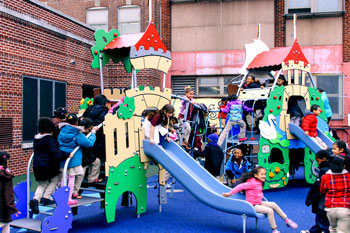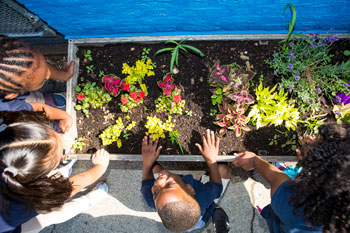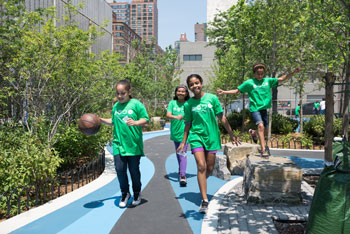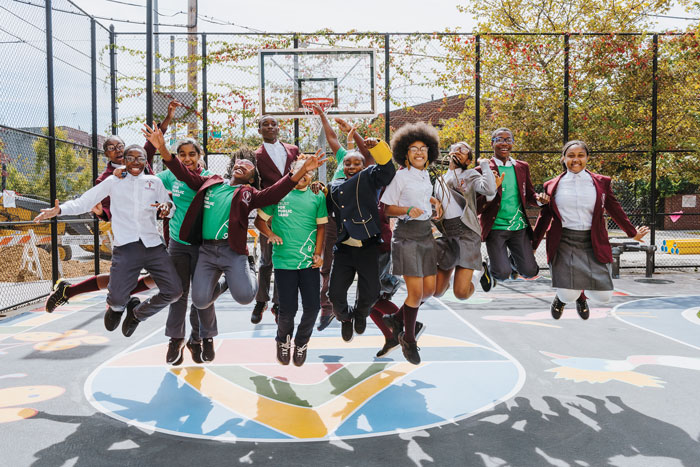In some communities across the United States, schoolyards are becoming much more than just a place for kids to run around during recess. Schoolyards are being transformed into active outdoor spaces, parks and more, with the addition of trees and gardens, as well as up-to-date play equipment—to be enjoyed beyond school hours.
The Trust for Public Land, a nonprofit organization that creates parks and protects land for people, released a report, “Community Schoolyards Projects: A Game-Changing Solution to America’s Park Equity Problem,” that focuses on how taking “underused asphalt schoolyards and transforming them into vibrant public parks that stay open after school and on weekends can bring health, equity and education benefits to students and communities.”

“The schoolyard is an often-overlooked component of community infrastructure that is packed with potential,” said Trust for Public Land CEO and President Diane Regas. “Together, we can address the unhealthy state of the nation’s schoolyards so that students have access to opportunities for recreation, outdoor learning and physical activity, setting them up for a lifetime of success. And transforming schoolyards into shared public parks is also a common-sense, cost-effective solution to America’s park-equity problem—filling a void for communities by providing new access to public greenspace.”
According to information from the Trust for Public Land website, “Opening all public schools to local communities during non-school hours would give nearly 20 million additional people in the U.S., including 5.2 million children, access to park space within a 10-minute walk of their home.” What’s more, data on the outcomes and impact is included in the report, as well as expertise from about 300 Community Schoolyards projects that the “Trust for Public Land has supported across the country through a participatory design process, working with communities to envision schoolyards that meet everyone’s needs.”
Why Communities Are Transforming Schoolyards
Communities are deciding to renovate their schoolyards for various reasons, with Danielle Denk, the Trust for Public Land’s schoolyards initiative director, pointing to four indicators.
“First, city officials who want to increase access to a park within a 10-minute walk are supporting school districts to open their doors by entering into shared use agreements, supporting maintenance, programming and operation of school sites,” Denk said.
“Our research shows that opening the nation’s schoolyards to the public during non-school hours would put a park within a 10-minute walk of nearly 80 million people, including 20 million nationwide who currently lack access to public green spaces,” she said, adding that 100 million people in the U.S., “including 28 million children, do not have access to a quality park within a 10-minute walk from home.”
A second indicator as to why more communities are transforming schoolyards is that “COVID has revealed the importance of learning outside. Teachers are taking students out in the fresh air for instruction and realize they are more attentive, retain content and come back inside ready to learn,” she explained. “Teachers and school administrators report that attendance and behavior improve following schoolyard renovations.”

Third, “Decision-makers are seeing the health and climate outcomes associated with Community Schoolyards. Access to green space and time spent in nature are associated with a number of positive outcomes: reduced stress, less depression and anxiety, improved concentration, lower obesity rates, and reduced blood pressure,” Denk said.
“Revitalizing these spaces with specially landscaped gardens, bioswales and porous surfaces to absorb stormwater can also help prevent floods and cool down surrounding play spaces. Schoolyard transformations are moving from ‘nice to have’ to ‘need to have’ health, climate and educational interventions,” she explained.
Noting a fourth indicator, Denk said “TPL and other organizations are working to demonstrate, advocate and scale this intervention. TPL started the Community Schoolyard Catalyst Fund to support and train school districts and local partners in how to create Community Schoolyards that advance health, equity, education and climate outcomes. To support the movement, we have created a host of technical resources to empower local action.”
She added that “Recognizing that there are 100,000 schoolyards on 2 million acres across 14,000 school districts, TPL cannot do this work alone. We are lending our decades of experience to drive a coalition of national and local partners, working together, to move this intervention into sustained, equitable action.”
Schoolyard Renovations
Communities that are making the most of their schoolyard space are giving children and community members better access to public parks and greenspace.
Trust for Public Land has been helping schools achieve this across the U.S., with the nonprofit having helped more than “260 schools transform their asphalt schoolyards into vibrant, Community Schoolyards that serve as outdoor classrooms, playgrounds and parks with nature-rich gathering spaces for students and communities,” according to Denk.
In Newark, N.J., for example, Trust for Public Land worked with the school and community to renovate the schoolyard at the K–8 Sussex Avenue School in 2015.
“Students led the design of the new schoolyard, advising landscape architects on the vision, amenities and layout, and designed a multipurpose recreation field and running track to promote physical activity. The half-acre schoolyard now teems with trees and flowering shrubs, which promote health, well-being and learning,” Denk said. “Granite blocks have been fashioned into an outdoor classroom so students can go outside to learn about science, math, reading and social studies.”

In another example in Dallas, Trust for Public Land is working with the Texas Trees Foundation to renovate 20 schoolyards.
Denk noted that “According to Elysse Alvarado, Trust for Public Land’s program manager for Community Schoolyards projects in Dallas, each of the six schoolyards in the first phase, completed last fall, received between 80 and 150 new native trees. Besides scant tree cover, the other thing the six schoolyards previously had in common was their inaccessibility.”
And, according to Denk, Alvarado said that “All had been closed to the community—fenced and gated after school and on weekends,” and that most of the schools are surrounded by apartment buildings that lack green space. The schoolyards now are open to the public after school hours, and “function as a neighborhood park.”
“A prime example of our schoolyards connecting rural communities to outdoor space is in Huntington, Vt., where a community forest, which Trust for Public Land helped the town purchase this spring, serves as an extension of the local elementary school,” Denk said.
“The 245-acre forest, located next to Brewster-Pierce Memorial School in the Green Mountains, is used by students and teachers for science exploration and nature hikes,” she said. “Now that the land is publicly owned, the physical education program hopes to create a low-ropes course and a mountain biking trail.”
What’s more, Community Schoolyards spaces in New York City “capture 19 million gallons of stormwater a year, helping to prevent combined sewer overflows into surrounding waterways,” Denk noted, adding that in Philadelphia, “our renovated schoolyards capture 17 million gallons of stormwater annually.”
“Over the years, captured rainwater has prevented a quarter of a billion gallons of diluted sewage from entering the creeks and rivers surrounding New York and Philadelphia,” she said. “Due to vast water quality improvements, thanks to schoolyard, parks and other green infrastructure interventions in Philadelphia and Camden, the Delaware River was named the ‘River of the Year’ by American Rivers in 2020.” RM



